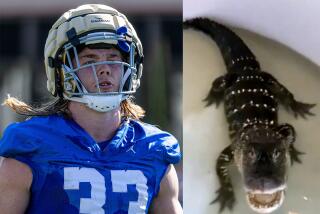Alligator Annie and ‘Friends’ a Hit With Tourists
- Share via
HOUMA, La. — “Isabelle, come on baby! Charlie, Boomer, Otto, Fifi, come on! Hurry up!”
In answer to 78-year-old Annie Miller’s voice, her swamp friends cut silently through the dark bayou water, arrow-shaped wakes marking their progress toward her boat.
Only when they close in to lunge for the hunks of raw chicken she slaps on the water are her friends identifiable: alligators, some very large alligators.
For 14 years, Miller--known as Alligator Annie--has made a living introducing visitors to the swamps outside Houma, 50 miles southwest of New Orleans. She proudly points out their glories--after all, this is her back yard--and their dangers.
“Now, all of you, keep those hands inside the boat,” she cautioned passengers in English and French on a recent tour. “Especially watch those children. My friends here, they don’t know the difference between a hand and a chunk of chicken.”
Her husband, Ed, who transplanted himself from Oklahoma to Louisiana 35 years ago, added, “The big ones have a bite of 1,000 pounds of pressure per square inch.”
She easily maneuvers the 24-seat aluminum barge through channels clogged with blooming water hyacinths and downed trees from Hurricane Andrew, warning passengers when to duck beneath moss-draped oak branches dipping toward Bayou Black.
A short, stocky figure with cropped gray hair and an open, sun-browned face, Miller finds it easy to share her lifelong love of the bayou country with visitors.
“Over there, look at that hawk. And that’s a great blue heron,” Miller said. “The eagles aren’t back yet but should be coming in any day.”
But for every scene and creature she points out, there is an accompanying lament from the Millers for something lost from the swamps, generally because of man-made changes.
“We had a lot of deer, a few bear in the hardwood swamp” north of the Intercoastal Waterway. “There used to be so many otters here,” she said. “We’d sit for hours and watch them play. Catch some of the young ones and tame them for pets. Wonderful little creatures.
“About 20 years ago, we sold two to Walt Disney (Productions) and they starred them in a couple of movies,” he said. “But there’s hardly any left. Over-trapping got some, and pesticide runoff from (sugar) cane fields contaminated the fish they ate and killed them.
“It’s a shame,” she said. “People are doing things better but it’s too late for a lot of it. The swamp will never come back like it was. Nor the marshes either. What man hasn’t killed or carved up, the storms have.”
Miller grew up hunting, fishing and living off the land in a home nearby where her parents spoke only French. Wisps of the lilting Cajun accent still flavor her speech.
After meeting Ed, an oil field worker, at a dance 36 years ago, the first place she took him was duck hunting.
A few months later, his neck was broken in a fall but Miller insisted that the wedding proceed as planned, except to have it held in the New Orleans hospital where Ed stayed for a year.
With Ed unable to walk for months after his release, she turned to the swamps for their livelihood. For 18 years, they raised their two adopted sons by catching snakes--up to 200 a day--to sell to zoos and laboratories.
Between those expeditions, they trapped nutria and muskrat, crabbed and fished until the Houma Chamber of Commerce asked Miller to give swamp tours in response to tourists’ requests.
She complied and began feeding the alligators a little chicken to draw them to her boat so tourists could get a safe but close-up view of the antediluvian creatures.
Identifying their markings and giving them names soon followed. Charlie has crooked teeth from being caught on a fisherman’s hook. Mike was blinded in one eye by a hunter. And Isabelle, a 15-footer weighing about 700 pounds, turned out to be a male but the name stuck.
Now she feeds them almost two tons of chicken a year.
Her success at drawing visitors to the area led the local government to declare sections of the marsh and bayous as “alligator preserves.” Armed with a shotgun, she often patrols those areas at night to scare off poachers.
Once, her husband said, she brought in a deer poacher at gunpoint and turned him over to authorities.
“I’ve lived off the land all my life, but I hate killing just for killing, wanton slaughter. And I fight it,” she declared. “I fight for my gators too.
“Move it, Otto, you had enough. Give old Mike some more,” she told Ed. “He’s still hungry.”
More to Read
Sign up for The Wild
We’ll help you find the best places to hike, bike and run, as well as the perfect silent spots for meditation and yoga.
You may occasionally receive promotional content from the Los Angeles Times.






